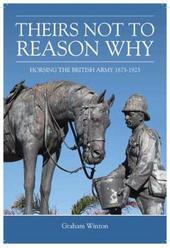
|
'Theirs Not to Reason Why': Horsing the British Army 1875-1925
Hardback
Main Details
| Title |
'Theirs Not to Reason Why': Horsing the British Army 1875-1925
|
| Authors and Contributors |
By (author) Graham Winton
|
| Series | Wolverhampton Military Studies |
|---|
| Physical Properties |
| Format:Hardback | | Pages:520 | | Dimensions(mm): Height 234,Width 156 |
|
| ISBN/Barcode |
9781909384484
|
| Classifications | Dewey:357.10941 |
|---|
| Audience | |
|---|
| Illustrations |
40 b/w illustrations, 8 maps, 8 tables
|
|
Publishing Details |
| Publisher |
Helion & Company
|
| Imprint |
Helion & Company
|
| Publication Date |
15 October 2013 |
| Publication Country |
United Kingdom
|
Description
This book provides the first comprehensive study of the British Army's horse services between 1875-1925, including the use of horses in the 1899-1902 Anglo-Boer and the 1914-18 wars. There is a particular focus on the military procurement of horses in relation to the domestic horse breeding industry, foreign supply in times of war, the debate about mechanisation versus the horse and an integrated military transport system. During the 1899-1902 war the recently created Army Veterinary and Remount Departments and Horse Registration Scheme were severely tested and found wanting. Following the appalling suffering and loss of horses during this War, the period 1902 to 1914 was critical for the development of the horse services. The crucial elements in effectively horsing the Army were recognised - supply, care, and organisation. The Army depended on the creation of a rapid and effective horse mobilisation scheme and the ability to sustain expansion in the field. The civilian horse market was central to the supply of military horses in peace and war, and by obtaining reliable information on the number and type of horses available to them, the Army could guarantee a regular supply. There was also a need to learn lessons from the 1899-1902 war for the planning and expansion of auxiliary services, for example blacksmiths, saddlers, remount depots and veterinary hospitals. On the outbreak of war in 1914 the Army had an organised reserve and mobilisation scheme; a completely integrated transport system using horses, mechanised vehicles and rail networks. As the war progressed there were serious questions about the continuing supply of horses from both home and world markets, shortages of transport for moving them from the country of purchase and the growing submarine menace. Developments by 1919 in mechanical vehicles were acknowledged by many as signalling the end of the military reliance upon the horse, even though it remained the main source of motive power, and cavalry the main arm of exploitation.
Author Biography
Graham's lifelong interest in and study of military, social and landscape history has given him an understanding of military horses and their supply. This was the focus of his Ph.D thesis, 'Horsing the British Army 1875-1923'. He has had a number of articles published on horses in the First World War, mechanisation and army transport system. This book is a culmination of many years of research and experiences. He has organised many study tours to the battlefields of the First World War, taking veterans back to France, often for their first time. As a result, he has been privileged to spend time with them and listen to their memories of horses and the landscapes over which they operated. Having had experience of carriage driving, working with heavy horses and riding over a number of battlefields, Graham can combine a detailed knowledge of historical materials and sources, with a practical understanding of horses in the landscape. Graham retired in 2008 as Principal of a College of Adult Education to concentrate on research, publishing and tutoring. He is a part-time tutor with the University Of Cambridge Institute Of Continuing Education and has lectured in the USA and extensively in England. In 2013 he was made a Fellow of the Royal Geographic Society.
Reviews...a fascinating read, where incredible amounts of research and considerable knowledge have been employed. If you have a passion for combat history and an interest in all things equestrian, this should be your one-stop shop. * History of War Magazine *
|